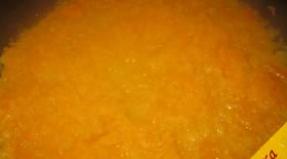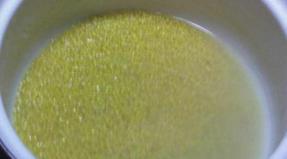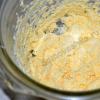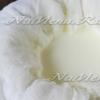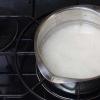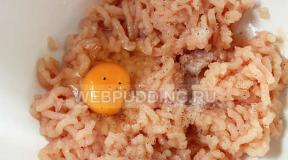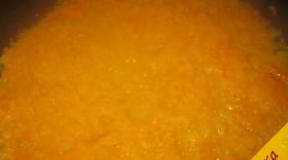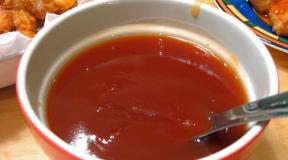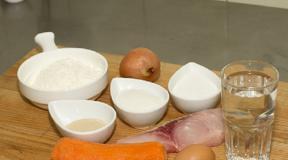Cooking spicy horseradish at home recipe. Khrenovina - nine classic recipes for cooking for the winter
The root of this plant contains several times more vitamins than citrus fruits. It can have a beneficial effect on the body's immune system, stimulate the digestive system, and increase muscle tone and endurance. This is not ginseng, as one might assume, but a simple horseradish root, known to everyone. You can use it to prepare various homemade sauces, pickles, soft or hot drinks by taking your favorite horseradish recipe from the selection below.
There are different recipes for sauces based on the horseradish root, but most appreciate the classic table horseradish recipe for its ease of preparation and purity of taste.
For a small portion of sauce you will need:
- 300 g horseradish;
- 200 ml hot boiled water;
- 5 g salt;
- 20 g sugar.
Recipe step by step:
- Wash the horseradish roots, peel them and finely grate them. You can grind them in a blender, but the most reliable way is grandma’s hand grinder.
- Dissolve salt and sugar in hot water. When the temperature of the solution reaches 40–50 degrees, pour it into the crushed main ingredient and mix.
- Divide the dressing into small, tightly sealed jars. Before using, let the sauce sit for at least 2-3 hours.
It can be stored for up to 2-3 days. To extend the shelf life, add a little vinegar.
How to prepare food for the winter?



The easiest way to prepare horseradish for the winter is to make a “breathtaking” sauce from it with a minimum of ingredients:
- 1000 g horseradish roots;
- 30 g salt;
- 60 g sugar;
- 1 lemon (can be replaced with a few drops of apple or wine vinegar);
- water.
How to make a blank:
- Grind the roots into a paste using any available method, add salt and sugar to it. Mix everything well and add boiling water until the cream becomes thick.
- Place the workpiece in sterile small containers and sterilize for five minutes. Then add a few drops of lemon juice or vinegar to each jar, seal with lids and store in a cool, dark place.
To prevent the aroma of the dressing from dissipating after opening the seamer, you should choose small containers.
Cooking "Chrenoder" at home
Gorloder, horseradish, horseradish are the names of the same sauce with a strong taste, the main ingredients of which are only three products: horseradish root, garlic and tomatoes. In addition to excellent taste, this dressing also has a number of useful properties, including increasing the immune functions of the body.

And the proportions of products for its preparation will be as follows:
- 2000 g ripe tomatoes;
- 200–300 g horseradish roots;
- 30–50 g garlic;
- 30 g salt.
Cooking method:
- Wash the tomatoes, dry them, cut them into slices and cut off the place where the stalk is attached. Remove the peel from the garlic cloves. Peel, wash and chop the horseradish into pieces that will be convenient to put into a meat grinder.
- Grind all prepared sauce components in a fine-hole meat grinder, add salt, mix and place in prepared sterile jars.
After a day, all the components of the sauce will combine, making it as rich as possible.
Beet juice recipe
Horseradish with beets is a combination loved by many spicy lovers, since such an addition to meat and fish dishes not only gives an unforgettable taste sensation, but also pleases the eye with a pleasant color.

To prepare sauce with beet juice you need to take:
- 400 g horseradish roots;
- 150 ml water;
- 150 ml vinegar;
- 50 ml beet juice;
- 30 g salt;
- 20 g sugar.
Progress:
- The main ingredient of the sauce must be prepared: peeled, washed and soaked for two days in cold water. After such preparation, the horseradish is crushed as finely as possible (in a meat grinder, blender or grater).
- Pour sugar and salt into the root pulp, pour boiling water over it and stir. Grind a certain amount of beets and squeeze out the amount of juice required by the recipe through several layers of gauze.
- Mix beet juice and vinegar, pour into horseradish, stir. Place the finished dressing in prepared sterile jars, close the lids tightly so that the aroma does not dissipate, and store in the refrigerator for up to six months.
In order not to wash your face with tears when grinding the root through a meat grinder, you need to tie a thick plastic bag (for example, for freezing food) to the grill of the device.
Homemade with apples
This sauce is perfect not only for jellied meat, boiled tongue or lard. A small spoon of dressing in a plate of borscht or okroshka will have an “incendiary” effect on the taste buds.



Apple-horseradish sauce contains:
- 200 g horseradish;
- 100 g sweet and sour apple;
- 5 g powdered sugar;
- 3 g salt;
- 15 ml apple cider vinegar;
- 30 g sour cream.
How to cook horseradish with apples:
- Grind the prepared horseradish root using the finest grater. Do the same with the peeled and cored apple. To prevent the pungent aroma of the root from irritating the mucous membranes, you can grind the sauce components in a blender bowl.
- Add salt, sugar, sour cream and vinegar to the apple and horseradish pulp. Mix the sauce well. Store the snack in a tightly sealed container in a cool place.
Option with sour cream added
Homemade horseradish sauce with the addition of sour cream is good because you can independently adjust its spiciness by increasing or decreasing the amount of dairy product.

Basic ratio of filling components:
- 250 g horseradish root;
- 100 ml vinegar;
- 400 ml water;
- 20 g salt;
- 20 g sugar;
- sour cream to taste.
Cooking sequence:
- Grind the vigorous root using a grater or a meat grinder, pour boiling water over it in the amount specified in the recipe, and leave until it cools completely.
- Add salt, sugar and vinegar to the cooled horseradish. Mix everything thoroughly and put it in the refrigerator for at least 2-3 hours.
- Next, just before serving, mix a small amount of the product with sour cream to taste, for example, in a ratio of 1:2.
The easiest way to prepare horseradish roots
Among all the options for horseradish-based sauces, perhaps the simplest is Pechora-style horseradish with honey. This sauce can be stored for up to three months, since both honey and cranberries act as natural preservatives, but you should not prepare it for future use. The taste of the vigorous root becomes softer over time.



To make Pechora sauce you need to prepare:
- 200 g horseradish roots;
- 200 ml water;
- 50 g cranberries;
- 50 g honey.
Cooking algorithm:
- Grind the prepared fresh horseradish roots. Together with them, pass the cranberries through a meat grinder.
- Dissolve honey in warm, but not hot water. The water temperature should not be more than 70 degrees to preserve all the beneficial properties of the bee product.
- Next, you just need to pour the honey solution into the crushed products, mix them and place them in prepared jars.
Homemade sauerkraut with horseradish
The benefits of such a snack for the human body are invaluable: fermentation products have a beneficial effect on the microflora of the stomach, and the spicy root will help cope with harmful bacilli, which often cause colds.

To prepare it you will need:
- 2000 g white cabbage;
- 1500 ml water;
- 200 g carrots;
- 100 g horseradish root;
- 100 g sugar;
- 50 g salt;
- 3–4 bay leaves;
- 8–10 black peppercorns.
How to ferment cabbage with horseradish:
- Cut the stalk from the cabbage fork and chop the leaves into thin strips. Grind the carrots using a coarse grater, and the horseradish root using a fine grater.
- Mix all the vegetables well, add spices and pack tightly into a glass or enamel container.
- Boil water, dissolve salt and sugar in it. When the solution has cooled, pour it over the prepared cabbage.
- Cover the container with a lid and leave at room temperature to ferment.
After three to four days the cabbage is ready. For further storage, it is moved to the refrigerator.
Step-by-step recipe for horseradish
By decree of Peter the Great, this drink was to be given (in small quantities, of course) to all people working in the cold. But those who don’t spend a lot of time in the cold will also like horseradish tincture, since honey makes the drink soft, and horseradish completely deprives it of the alcoholic smell.



List of products used:
- 500 ml vodka;
- 50 g fresh horseradish root;
- 50 g honey.
Technology for preparing the tincture:
- Place the peeled horseradish and cut into small pieces into a container of a suitable size and pour in the honey. Pour vodka over everything.
- Next, take an immersion blender and blend everything as thoroughly as possible. Pour the resulting mixture into a container of a suitable size, seal it tightly with a stopper and put it in a dark place for 4–5 days.
- Every day you need to shake the contents of the bottle and check if the smell of alcohol has disappeared. As soon as this happens, you should strain the tincture through a paper towel to get rid of not only the crushed root, but also the honey, since it tends to precipitate in flakes.
Horseradish should be stored in the refrigerator.
Homemade horseradish kvass
The benefits of the vigorous root are invaluable not only in the cold season. Even on hot summer days it can give you that much-desired coolness. Those who do not believe in its refreshing effect can try making kvass at home from rye bread and horseradish.

This drink contains:
- 6000 ml water;
- 1400–2100 g rye bread;
- 250 g horseradish root;
- 250 g sugar;
- 50 g pressed yeast;
- 50 g honey (it is better to take meadow honey or herbs);
- 30 g white raisins.
Prepare a soft drink as follows:
- Cut the rye bread into small pieces and dry in the oven until it becomes crackers with a thick crust. Place the bread in an enamel or glass container and pour boiling water over it. Leave for 3–6 hours.
- Strain the cooled and infused wort, dissolve sugar and yeast in it. As soon as foam appears on the surface of the liquid - the result of activation of yeast - add grated horseradish and honey.
- After steeping the kvass for three hours, filter it and pour it into bottles, putting a few raisins in each. After this, the drink should ripen for another two to three days in a cool place. Then you can put it in the refrigerator.
Cinnamon and clove sauce



For a spicy sauce made from horseradish rhizomes with spicy notes of cinnamon and cloves, you need to take:
- 600–800 g horseradish roots;
- 500 ml water;
- 55 ml table vinegar;
- 25 g salt;
- 45 g sugar;
- 4 buds of cloves;
- 5–10 g cinnamon powder.
Preparation procedure:
- Place the peeled, washed and chopped roots into a dry glass jar of a suitable size. After this, you can start preparing the spicy filling.
- After dissolving crystals of sugar and salt in water, bring this mixture to a boil. Place the clove buds into the bubbling solution and boil for three minutes.
- When the filling has cooled to room temperature, you need to strain it and add cinnamon and vinegar. Let it brew for a day.
- Pour the aromatic spicy filling into the grated horseradish and leave for a day or two.
A long time ago, back in the last century, when I was still very small, there was such a big country - the Soviet Union. There wasn't really anything in it. Literally and figuratively. Although, I don’t argue, it was fun.
I remember on the eve of my birthday (November 7, October Revolution Day), my parents were preparing a celebration.
As usual, in addition to excellent drinks, the obligatory herring under a fur coat, pickled mushrooms and the usual jellied meat. And what would it be without grated horseradish???
What about stuffed pike, aspic or boiled pork?? It's like drinking beer without gas. There is fluid, but no exhaust. Different recipes will turn out differently.
Dad either came up with the recipe himself or took it from someone, I don’t know. But hell, it’s not for nothing that it’s the hottest of the “domestic” seasonings. It always turned out atomic. It was possible to set fire to the water in the Dnieper.
Usually now we prepare the seasoning just like that, without tying it to events. The jar just sits in the refrigerator, even just to spread on bread.
Homemade horseradish. Step by step recipe
Ingredients (0.5 l)
- Horseradish rhizomes 0.5 kg
- Red beets 1 piece
- Sugar to taste
- Salt to taste
- Table vinegar to taste
- Horseradish (Armoracia rusticana) grows almost throughout Europe, except the Arctic. Usually the leaves are used for preservation, most often cucumbers, and the thick fleshy roots are used to prepare table seasoning. In Rus', rhizomes were used more widely, and for preservation, and for salting everything, and for spicy kvass, and for such a wonderful and close in spirit to any of our compatriots - horseradish.
Horseradish (Armoracia rusticana)
- I read in a smart book that the glycoside sinigrin gives horseradish its pungency and pungency. Relatives - mustard, watercress, radish. The ancient Romans, Greeks, and Egyptians used burning roots.
- Horseradish has always been used as a medicine. But whatever one may say, without preparation, it’s just a root. Fat, dirty and not appetizing.
- First, you need to buy the roots of the plant. In autumn and winter it’s not difficult. And in the summer they sell it last year, and it is of little use. Today we bought almost half a kilogram. Just the way it should be.
- Next, the roots need to be cleaned with a sharp knife. Cut off the ends.
The roots must be cleaned with a sharp knife
- After this, the roots must be thoroughly washed and cut into pieces, the length of a match or a little longer.
- I soak the roots, although many claim that this reduces their pungency. Well, much stronger. And so you can jump out of your slippers. It should be soaked in cold, almost ice-cold water. About 5-6 hours. We put it in the refrigerator.
Soak the peeled roots in cold water
- Then the roots need to be chopped. Many people grate by hand. Well, I'm not a sadomasochist. Bullying myself and family members does not suit me. An electric meat grinder is ideal.
- During my childhood, when an electric meat grinder was less common in the kitchen than a UFO over Kiev, my dad crushed the rhizomes with an ordinary manual meat grinder screwed to the table. For insurance, they kicked me out into the street, and my mother went to a neighbor for 10 minutes and asked my dad to stir the soup every half hour. Dad was twisting the horseradish with a manual meat grinder, lifting the table off the floor. Hard work. Everything was done only in a gas mask.
After that, it was impossible to enter the kitchen for another three hours. Ventilation did not help either. - I keep thinking, why not then put a plastic bag on a meat grinder and collect the twisted root along with the caustic fumes in it. Then I understood. Who remembers how rare plastic bags were in the 70s??? They simply weren't there. They were washed and dried. For reuse.
Grind the roots using a grater or meat grinder
- The crushed root was carefully placed in a large jar and covered with a plastic lid. Well, for example, let’s give not a large one, but a half-liter one. After this, decontamination began in the kitchen.
- Don't experiment. An ordinary bag for the exhaust of a meat grinder, hold it with your hand. You can feed your baby nearby and no complaints. At least to the point. Unless it's out of harm's way.
Transfer the crushed seasoning into a jar with an airtight lid.
- Next, a large red beet (beet) was pulled out of the refrigerator. The beets were peeled and crushed using the finest grater until they became dusty. The juice was squeezed out using a piece of cotton cloth and poured into a jar with seasoning. A heaped tablespoon of sugar and a teaspoon of coarse salt were added to the same jar.
Squeeze out the juice using a piece of cotton cloth and pour into a jar with seasoning.
- Mix everything thoroughly and add 2 tablespoons of regular food vinegar. Add chilled boiled water so that the contents of the jar are all in liquid. But don't overfill it.
- Mix again. The seasoning is already bright pink.
- To taste, add salt, vinegar, sugar. And water. The liquid should be level with the grated seasoning. The seasoning must infuse and mature. Overnight in the refrigerator. Overnight, the roots will become saturated with color and release a pungency into the liquid.
The dish, the basis of which is grated horseradish root, has a lot of names - horseradish, “Ogonyok”, Russian adjika, horseradish. Horseradish is a traditional spice for Russian cuisine. The fiery “temper” of the seasoning is familiar to everyone, but not everyone likes the spicy product. Horseradish has long been a regular on both noble and peasant tables. It was served with fish aspic, jellies, and meat dishes. The combination of jellied meat and horseradish has always been especially popular. The sauce gained its “leadership laurels” on the Russian table when mustard appeared in the 18th century.
Nevertheless, horseradish still has fans today. Lovers of a fiery, piquant taste prepare sauce from the rhizomes of the plant. Chopped garlic and tomatoes are added to the main component. In addition to the specific sweet-evil taste and smell, the vigorous seasoning has a beneficial effect on the body.
The content of the article:
1. Benefits of the freezer
Benefits of the freezer
The benefits of fresh ingredients for the body are great. The highest concentration of nutrients is maintained for 14 days from the date of preparation of the sauce. That is why freshly prepared “light” is more valuable. What's so special about the seasoning?
- Horseradish increases metabolism, promoting weight loss. The fiber contained in the plant cleanses the body of toxins.
- The components in the complex provide an antibacterial effect, which helps to avoid colds. Consuming the sauce daily in small quantities strengthens the immune system.
- Horseradish lowers blood sugar levels and is therefore recommended for diabetics.
- The tomatoes that make up the seasoning are rich in microelements.
- Chrenoder can be eaten in small quantities to prevent vascular and heart diseases.
- Russian adjika has a beneficial effect on the gastric tract. Improves appetite and digestion of food.
Contraindications for horseradish snacks
Like any product, seasoning has contraindications. So, if you have stomach problems, especially those with ulcers and gastritis, you should avoid the sauce. In case of hypersensitivity to the components, the dish is also prohibited.
It is important to observe moderation when consuming Russian adjika. In large quantities, the hot mixture can harm the mucous tissues of the digestive tract.
What to combine horseradish with?
If the strong taste of horseradish is not to your liking, then it can be slightly adjusted. To do this, various spicy vegetables and spices are added to the main ingredients - garlic, tomatoes and horseradish.
- Honey and sugar enhance the sweetness of the gorloder.
- Natural vinegar, fresh lemon or tomato juice removes the excessive causticity of the main component. In return, the appetizer receives additional spiciness. Using these components, the shelf life of the snack can be increased.
- Garlic adds amazing flavor to the sauce.
- Burning spiciness can be achieved by adding chili pepper to the seasoning.
- You can refine horseradish with mayonnaise or sour cream.
Methods for preparing horseradish
There are two known options for preparing hot seasoning - raw without cooking and preparing for future use, requiring heat treatment. In the first case, the products completely retain their vitamin reserves. The snack should be stored in the refrigerator to prevent it from turning sour. If you need to extend the shelf life of fresh seasoning, it can be sent to the freezer.
When canning, food must be cooked; vegetables lose some of their nutrients, but processing allows the sauce to be preserved for a long period. To seal, you will need small sterilized jars (0.35 or 0.5 ml). By choosing this method of preparing “light” you can enjoy the piquant taste of horseradish until the summer.
Any housewife will master this quick and easy way to prepare horseradish seasoning. The horseradish in this recipe is not “diluted” with other ingredients, and therefore the sauce will be vigorous. The dish can be served with soups or meat. The finished seasoning should be stored in a cool place - in a cellar or refrigerator for several months. The recipe is for 10 servings.
Components:
- 500 g of peeled horseradish rhizomes;
- 0.25 l of filtered water;
- 20 g sugar;
- 10 g salt;
- 25 g table vinegar;
- cloves and cinnamon according to preference.
How to cook:
- Peel the skin of the horseradish roots using the scraping method, cut into small pieces and grind in a convenient way - on a grater, in a food processor or with a meat grinder.
- Fill pre-sterilized cylinders 2/3 full with the resulting horseradish mass.
- Pour water into a metal container, add salt and sugar. Boil on the stove. Add spices.
- Cool the liquid to 50° C and combine with vinegar.
- Pour the brine into containers with ground horseradish and roll up the lids.

This recipe is considered traditional. To prepare, you need only 3 ingredients - horseradish, tomatoes and garlic. The process of making the snack itself is not difficult, but before doing this, the vegetables must be properly prepared. You need to remove the seeds from the tomato; neglecting this procedure will shorten the shelf life - the seasoning may ferment. The quantity of products is designed to prepare 10 servings.
Components:
- 1.5 kg tomato;
- 125 g each of horseradish and garlic;
- 1.5 tablespoons salt;
- 1/2 tbsp. granulated sugar.
How to cook:
- Remove the skin from the tomato to make it easier, first place the vegetable in boiling water for a minute.
- Remove the seeds from the tomatoes.
- Scrape the skin off the horseradish and peel the garlic.
- Grind all components in a meat grinder.
- Add sugar and salt to the resulting mass.
- Place the pulp into pre-sterilized containers. Screw on the lids.
- Keep cool.

This snack has a bright color, vigorous taste and piquant aroma. The recipe is very easy. The workpiece uses a minimum of components. To make the treat tasty, you need to choose the right rhizomes of the main ingredient. Freshly harvested horseradish root is ideal. The proportions are for 10 servings.
Components:
- 400 g beet salad;
- 800 g horseradish rhizomes;
- 0.2 l of purified water;
- 2 tbsp. table vinegar;
- 2 tbsp. Sahara;
- 2 tsp salt.
How to cook:
- Scrape the skin off the horseradish. Grind the rhizomes in a meat grinder (you can use a food processor).
- Peel the beet root and chop it in any convenient way. You can put only beet juice or the whole grated vegetable into the preparation.
- Mix horseradish and beets. Add salt, sugar, water and vinegar. Mix everything.
- If the beets are not too juicy, then the amount of water can be increased. And vice versa.
- Sterilize sauce containers. Spread the seasoning and screw on the lids. Place the horseradish in the refrigerator for storage.

“Spark” according to this recipe can be “diluted” with fruity flavor notes by adding to the main components of the snack, for example, plums. A slight sourness distinguishes the sauce prepared according to this recipe from the classic one. Thanks to this, the seasoning gives ordinary dishes a spicy taste. The manufacturing method is simple, but a novice cook may need a more detailed diagram with a photo. The quantity of products is designed for 20 servings.
Components:
- 2 kg tomato;
- 600 g horseradish rhizomes;
- 400 g garlic;
- 2 pods of hot pepper (according to preference);
- 400 g plums with sourness;
- 2 tbsp each salt and sugar;
- 200 ml vinegar.
How to cook:
- Prepare the ingredients - peel the horseradish, tomatoes, garlic. Remove the bones from the plums. Remove the seeds from the pepper. Rinse the products under water and dry.
- Grind the ingredients with a meat grinder. Add salt, sugar and vinegar.
- Place the sauce in sterilized containers, screw the jars on and store in the refrigerator.
- The seasoning can be stored for up to six months. To increase shelf life, the seasoning must be boiled before putting it into cylinders.

Not a typical recipe for horseradish - no tomatoes. Instead, hot and sweet peppers are added to horseradish and garlic. The spicy, fiery and vigorous mixture will appeal to fans of thrills. The method for making “nuclear” sauce is simple; it is important to maintain the exact proportions of the products. Amount of ingredients is given for 20 servings.
Components:
- 0.4 kg of horseradish rhizomes;
- 0.4 kg of hot pepper;
- 0.4 kg of sweet pepper;
- 0.4 kg garlic;
- salt according to preference.
How to cook:
- Prepare vegetables. Scrape the skin off the horseradish, remove the seeds from the peppers, and remove the peel from the garlic.
- Grind the ingredients in a convenient way, mix, and add salt to taste.
- Place the seasoning in pre-sterilized containers and close with lids.
- The sauce must be stored in the refrigerator. Shelf life – up to six months.

The appetizer is ideal for meat in any form, especially jellied meat and jelly. The sauce can be used to diversify soup, salad, or make a sandwich with an unusual taste. Provided that the horseradish is prepared directly for the table, and not for future use, vinegar does not need to be used. In the absence of fresh rhizomes, you can use dry preparation. It's easy to do.
To do this, the rhizomes of the plants are crushed, dried and ground into powder. Before using in sauce, horseradish powder is soaked until it swells in water at room temperature. You can add pepper, lemon zest, garlic and various spices to the list of main ingredients. The quantity of products is designed for 4 persons.
Components:
- 100 g horseradish rhizomes;
- 4 medium apples;
- according to preference, garlic;
- 2 pinches of salt;
- sugar if desired;
- 2 tsp table vinegar.
How to cook:
- Peel the apples and remove the seeds. Bake the fruit in the oven.
- Peel the horseradish rhizomes.
- Grind apples and horseradish in a meat grinder.
- Add salt, sugar if desired, and add vinegar. Mix.
- Place in sterilized containers and cover with lids. Keep refrigerated.

The taste of this seasoning is especially piquant when it includes hot and sweet peppers. Even a beginner in cooking can handle the preparation - the ground products are mixed and served. For storage, it is better to choose small containers. The appetizer goes well with meat dishes. The amount of ingredients is designed for 4 persons.
Components:
- 0.5 kg of tomatoes;
- 0.1 kg horseradish roots;
- 0.25 kg bell pepper;
- half a chili pepper;
- 1/2 tbsp. vinegar essence;
- salt.
How to cook:
- Peel the skin from the rhizomes and grind.
- Peel the peppers and tomatoes, remove the seeds, and grind in a meat grinder.
- Mix the ingredients, add vinegar essence, and salt.
- Stir the sauce again. Place in prepared containers and cover with lids. Store in the refrigerator or cellar.

It is possible to prepare Ogonyok sauce in this way at any time of the year. Fresh tomatoes are replaced with tomato paste. This will slightly reduce the benefits of the snack, but the taste will remain unchanged. The main task is to choose the right paste; it should contain only natural products without additives. The recipe is for 10 servings.
Components:
- 0.5 kg of horseradish rhizomes;
- 0.2 kg of tomato paste;
- 0.5 kg bell peppers;
- 100 g vegetable oil;
- 1/2 cup sugar;
- 50 g table vinegar;
- half tbsp. salt.
How to cook:
- Scrape the skins from the rhizomes, remove seeds and skin from the peppers. Grind with a meat grinder or food processor.
- Add tomato paste to the chopped vegetables. Stir the mass, put on fire, cook for 10-12 minutes.
- Add salt, sugar, oil and vinegar. Boil for a couple of minutes.
- Place the sauce in glass containers (sterilized) and roll up.

Secrets of a delicious horseradish snack
To ensure Russian adjika has an excellent aroma and characteristic flavor, it is recommended to follow several tips. Then the result of the “fiery” seasoning will please you and less time will be needed for cooking.
- The choice of main raw materials must be approached seriously. The roots should be about 3 cm in diameter and no more than a quarter of a meter long. Small rhizomes do not have the “vigor” characteristic of a spicy vegetable; larger ones do not contain enough moisture. Spotted roots with damage are not suitable.
- Fresh rhizomes, as well as preparations for sauce, are stored in the refrigerator for no more than 20 days. The whole raw material is wrapped in cling film, the chopped roots are placed in a hermetically sealed glass container. When frozen, the shelf life of raw materials increases.
- For the “spark”, the maturity of the tomatoes does not matter. Both green vegetables and juicy ripe tomatoes are used.
- During long-term storage, the vigorous taste of horseradish “dissipates.” Increasing the amount of spicy and pungent ingredients - pepper, horseradish, garlic - for preparations that are planned to be stored for a long period of time will help to avoid this.
- Russian adjika can be frozen in small portions. This will increase the shelf life. Thaw the sauce before serving.
- The strong taste of horseradish seasoning can be enhanced by adding a little honey or sour cream.
And in conclusion, if you like spicy dishes, then you can diversify them not only with horseradish dressings, you can also use mustard.
How to make spicy mustard at home video
A long time ago, back in the last century, when I was still very small, there was such a big country - the Soviet Union. There wasn't really anything in it. Literally and figuratively. Although, I don’t argue, it was fun.
I remember on the eve of my birthday (November 7, October Revolution Day), my parents were preparing a celebration.
As usual, in addition to excellent drinks, the obligatory herring under a fur coat, pickled mushrooms and the usual jellied meat. And what would it be without grated horseradish???
What about stuffed pike, aspic or boiled pork?? It's like drinking beer without gas. There is fluid, but no exhaust. Different recipes will turn out differently.
Dad either came up with the recipe himself or took it from someone, I don’t know. But hell, it’s not for nothing that it’s the hottest of the “domestic” seasonings. It always turned out atomic. It was possible to set fire to the water in the Dnieper.
Usually now we prepare the seasoning just like that, without tying it to events. The jar just sits in the refrigerator, even just to spread on bread.
Homemade horseradish. Step by step recipe
Ingredients (0.5 l)
- Horseradish rhizomes 0.5 kg
- Red beets 1 piece
- Sugar to taste
- Salt to taste
- Table vinegar to taste
- Horseradish (Armoracia rusticana) grows almost throughout Europe, except the Arctic. Usually the leaves are used for preservation, most often cucumbers, and the thick fleshy roots are used to prepare table seasoning. In Rus', rhizomes were used more widely, and for preservation, and for salting everything, and for spicy kvass, and for such a wonderful and close in spirit to any of our compatriots - horseradish.
Horseradish (Armoracia rusticana)
- I read in a smart book that the glycoside sinigrin gives horseradish its pungency and pungency. Relatives - mustard, watercress, radish. The ancient Romans, Greeks, and Egyptians used burning roots.
- Horseradish has always been used as a medicine. But whatever one may say, without preparation, it’s just a root. Fat, dirty and not appetizing.
- First, you need to buy the roots of the plant. In autumn and winter it’s not difficult. And in the summer they sell it last year, and it is of little use. Today we bought almost half a kilogram. Just the way it should be.
- Next, the roots need to be cleaned with a sharp knife. Cut off the ends.
The roots must be cleaned with a sharp knife
- After this, the roots must be thoroughly washed and cut into pieces, the length of a match or a little longer.
- I soak the roots, although many claim that this reduces their pungency. Well, much stronger. And so you can jump out of your slippers. It should be soaked in cold, almost ice-cold water. About 5-6 hours. We put it in the refrigerator.
Soak the peeled roots in cold water
- Then the roots need to be chopped. Many people grate by hand. Well, I'm not a sadomasochist. Bullying myself and family members does not suit me. An electric meat grinder is ideal.
- During my childhood, when an electric meat grinder was less common in the kitchen than a UFO over Kiev, my dad crushed the rhizomes with an ordinary manual meat grinder screwed to the table. For insurance, they kicked me out into the street, and my mother went to a neighbor for 10 minutes and asked my dad to stir the soup every half hour. Dad was twisting the horseradish with a manual meat grinder, lifting the table off the floor. Hard work. Everything was done only in a gas mask.
After that, it was impossible to enter the kitchen for another three hours. Ventilation did not help either. - I keep thinking, why not then put a plastic bag on a meat grinder and collect the twisted root along with the caustic fumes in it. Then I understood. Who remembers how rare plastic bags were in the 70s??? They simply weren't there. They were washed and dried. For reuse.
Grind the roots using a grater or meat grinder
- The crushed root was carefully placed in a large jar and covered with a plastic lid. Well, for example, let’s give not a large one, but a half-liter one. After this, decontamination began in the kitchen.
- Don't experiment. An ordinary bag for the exhaust of a meat grinder, hold it with your hand. You can feed your baby nearby and no complaints. At least to the point. Unless it's out of harm's way.
Transfer the crushed seasoning into a jar with an airtight lid.
- Next, a large red beet (beet) was pulled out of the refrigerator. The beets were peeled and crushed using the finest grater until they became dusty. The juice was squeezed out using a piece of cotton cloth and poured into a jar with seasoning. A heaped tablespoon of sugar and a teaspoon of coarse salt were added to the same jar.
Squeeze out the juice using a piece of cotton cloth and pour into a jar with seasoning.
- Mix everything thoroughly and add 2 tablespoons of regular food vinegar. Add chilled boiled water so that the contents of the jar are all in liquid. But don't overfill it.
- Mix again. The seasoning is already bright pink.
- To taste, add salt, vinegar, sugar. And water. The liquid should be level with the grated seasoning. The seasoning must infuse and mature. Overnight in the refrigerator. Overnight, the roots will become saturated with color and release a pungency into the liquid.
Horseradish, gorloder, Siberian adjika, horseradish, ogonyok, cobra - all these are names of the same dish. A spicy sauce with a pleasant pungency and characteristic aroma goes well with meat, poultry, and just a slice of black bread. They also say that this vigorous, spicy snack can kill all germs, so you won’t be afraid of colds or gastrointestinal infections with it. And if you don’t yet know how to cook horseradish for the winter, I will be happy to share with you my favorite recipe.
What does it contain? Horseradish - tomatoes - garlic
The classic recipe for making horseradish - real, Siberian - requires using horseradish root and tomatoes, garlic and salt, often with the addition of chili pepper. It is tomatoes that are a mandatory ingredient in the sauce - they give it a pleasant sourness and soften the pungency of horseradish. Sometimes bell peppers and green apples are also added to the seasoning. But here it is important not to overdo it, because a horseradish snack must be spicy! Therefore, you can add vegetables, but in moderation, otherwise you will lose that very “punchy” taste for which we are preparing this product.
My recipe for horseradish snacks for the winter includes only tomatoes, horseradish root, garlic and salt. It turns out “baking” and very piquant. If it's too spicy for you, you can add more tomatoes or a couple of green apples at any time, depending on your taste.
Should I add sugar or not?
Sometimes granulated sugar is included in horseradish, especially if the tomatoes are too sour. I don't add sugar - it lasts longer. Instead, I try to choose sweet tomatoes, ripe, not green, then the sauce itself turns out to be sweet and sour. It’s good if the tomatoes are dense and not too watery so that the appetizer doesn’t “float.” For example, you can make a horseradish appetizer with plum tomatoes, which I think are just perfect for this appetizer.
How to make horseradish for the winter so it doesn’t go sour?
The horseradish snack stands well in the refrigerator under a nylon lid. The main thing is to put the correct proportions of garlic and horseradish so that the seasoning does not ferment and sour, and also store it strictly in the refrigerator, not in a warm place. If it is placed in sterilized jars and closed with clean lids, then additional preservatives (vinegar, citric acid or aspirin) are not required.
If the horseradish sours, then:
- jars are poorly sterilized;
- tomatoes are spoiled;
- little salt and garlic;
- the workpiece is in a warm place.
Glass containers are suitable for long-term storage (it is best to use small jars, 250, 300 or 500 ml). Thick nylon covers are suitable, as well as screw-on ones - it is advisable to place a couple of layers of cellophane under them to minimize air access and contact with metal.
How to extend the shelf life?
The snack lasts well all winter. But still, some housewives, fearing that it will ferment, try to extend its shelf life as much as possible. Some bring it to a boil, others add vinegar or a glass of oil...
I am categorically against any heat treatment, which kills all the usefulness of this Siberian snack. Vegetables and roots twisted through a meat grinder should be stored raw; if they are boiled, the taste will become incomparably worse. It won’t be crap anymore, but adjika at best.
You can extend the shelf life in one of two gentler ways:
- pour oil under the lid;
- grease the lid with mustard.
In the first case, the contents of the jar are filled with literally 1-2 tablespoons of vegetable oil. It forms a thin film that prevents mold from forming on top. An alternative option is to coat the lid with mustard. This will also prevent mold from forming in the jar, but without the extra calories in the end.
Ingredients for a classic horseradish recipe
- tomatoes 1 kg
- horseradish root 200 g
- garlic 4 cloves
- non-iodized salt 3 tsp.


